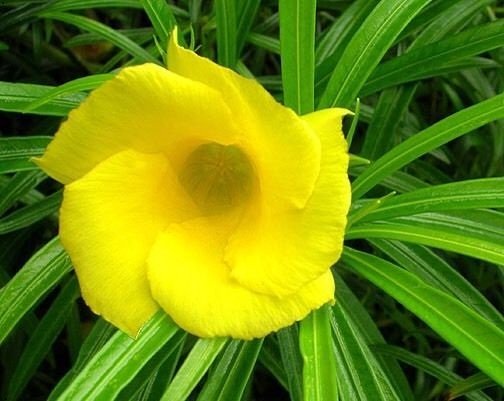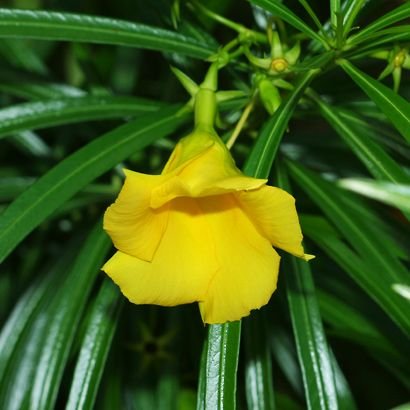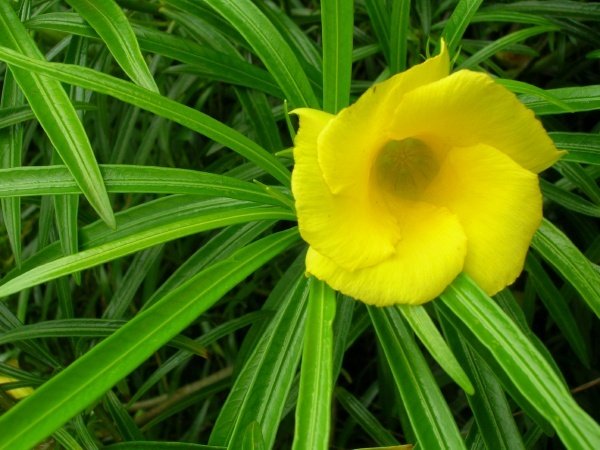
Regular name of this bloom is Thevetia peruviana. Its easily reasonable from the home grown name that the bloom is neighborhood to Peru of South America. It has a place with the plant family Apocynaceae. In English, this is known as Mexican Oleander, Yellow Oleander as it is immovably relative with Nerium oleander. In Bangladesh, we call this bloom as Kolke Ful for it's channel shape. Moreover it is known as Korobi Holud Korobi et cetera.

Yellow oleander trees are little to the point that various consider them broad briers. Yellow oleander information recommends that these evergreen plants rarely get in excess of 10 feet when created, disregarding the way that they can get to 20 feet in nature. The blossom of yellow oleander takes after a limited tube that flares out at the tip into five petals, bended into a winding shape. They are fragrant, around 2 inches long and create in gatherings. A framework inside the throat of the blooms helps with preparation. It coats dreadful little creatures needing the sweet nectar with clean, guaranteeing that they will trade tidy to the accompanying sprout. Yellow oleander trees' thick natural item has four sides and changes tints as it creates. The common item starts green, by then turns a lipstick red, yet finally forms into a dull dim. The stone inside is dull shaded and smooth and makes wonderful bits of gems.
Kolke sprouts are yellow in shading and having a shape like channel. Blossom can be in white or orange, however yellow is for the most part ordinary. Sprout is having a slight sweet fragrance. Leafs are thin and oleander like. Plant can create from little to a medium sized(not oftentimes) tree. The whole plant use to convey white sap when torn or broken.

Kolke(কলকে ফুল) bloom brings a nut like natural item which is incredibly harmful. Not certain why the all inclusive community from Caribbean use to call this blossom as Lucky Nut! Not only the normal item, in reality the whole plant is poisonous (remarkably if any part is ingested). However in the meantime this plant is having couple of restorative uses(help yourself to find out).This plant is by and large seen at Bangladesh, remarkably as favor blossoming plant.

yellow oleander trees create in savannahs and riparian zones in their nearby range in Africa. They can wind up prominent if created in open districts, and the trees have been recorded as destructive weeds in South Africa. In various countries, the usages for yellow oleander are, all things considered, enriching. In the United States, the tree is created as a garden plant, regardless of its noxious quality. Is yellow oleander toxic? Surely, it is. All parts of the plant is unsafe.

Various nursery specialists create yellow oleander paying little respect to its threat, allured by the plant's sumptuous, tropical look and persevering blossoms. If you have to build up this plant, it's OK to understand that yellow oleander mind isn't troublesome nor dreary. Essentially be careful about creating it around little adolescents and pets. Plant yellow oleander trees to a restricted degree or full sun, since they like warmth. The trees do best in well-exhausting soil with heaps of common substance, so work in compost before you plant. You'll need to water these plants routinely. Pruning and litter cleanup (wear gloves) will take a tiny bit of your chance as well. Generally, in any case, these are low-bolster plants.
Thevetia Peruviana || Yellow Oleander || Mexican Oleander || Cascabela Thevetia
Source
You have posted an image in an artistic tag (photography, art, etc.) without attribution or source. By doing so you are claiming to be the content creator.
Plagiarism is the copying & pasting of others work without giving credit to the origional author or artist.
Repeated plagiarism or tag abuse is considered spam. Spam is discouraged by the community and may result in action from the cheetah bot.
More information on Image Plagiarism
More information on artistic tags
If you believe this comment is in error, please contact us in #disputes on Discord